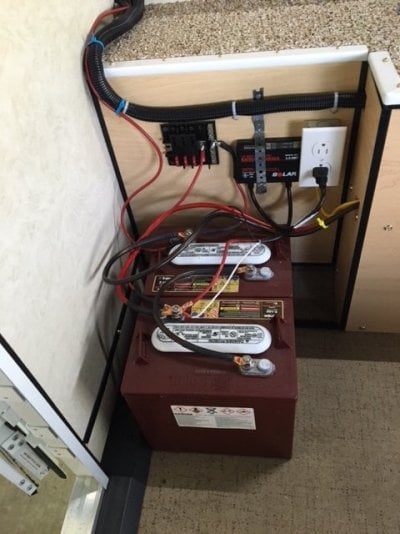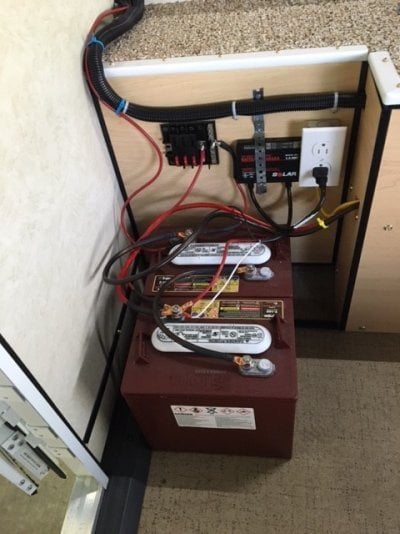I am building my new Raven shell. I am done putting in my electrical and batteries. I have two Trojan T105 batteries in the left rear. I will build a cabinet enclosing it all. I have two questions, A) do I need to vent it out to the outside and b) if so where should I put my vent. I am very nervous about cutting a hole in the camper because I do not know what is in the wall. Like where the frame is. When I cut a hole I want to do it right the first time, not to have two holes. Has anyone else done this?
You are using an out of date browser. It may not display this or other websites correctly.
You should upgrade or use an alternative browser.
You should upgrade or use an alternative browser.
Venting for battery
- Thread starter RKL
- Start date
Venting is important, and it should be to the outside. Probably even more important is to have a containment enclosure for the batteries to sit in. You want to make sure any kind of spillage stays within the enclosure.
Start with a small exploratory hole on the inside, make sure you don't hit a framing member, then you can explore around inside the cavity to get an idea of where the framing is and then can do your full size hole through the entire wall.
Start with a small exploratory hole on the inside, make sure you don't hit a framing member, then you can explore around inside the cavity to get an idea of where the framing is and then can do your full size hole through the entire wall.
billharr
Senior Member
Use a ice pick with a drill collar to find the frame members.
longhorn1
Ouch, that stings!
Are they AGM batteries or acid fill? If they are AGM I'm not sure FWC vents the cabinet.
You might also rethink the location. If at all possible, keeping the weight in front of the rear axle will be a much better solution. It will also cut down, even if just a little the bouncing around. Make sure they are very well secured, a lot of mass moving around tends to go where it wants. Add some electrolyte, makes for a bad day...
crumbs
Advanced Member
And for those who don't have everything, just yet:
https://www.ryobitools.com/phoneworks/inspection-scope
If it were just a one-time project, I'd go with the experience shared by the others above.
If the first hole don't work out so good, and you make it small enough, you can always cover it with a bubble level gauge.
https://www.ryobitools.com/phoneworks/inspection-scope
If it were just a one-time project, I'd go with the experience shared by the others above.
If the first hole don't work out so good, and you make it small enough, you can always cover it with a bubble level gauge.
nikonron
Senior Member
x2 on relocating them to the front wall of the camper, keep all heavy items as far forward as is possible. Ron
jbahr
Advanced Member
Vent through the "floor pack" the lower wood walls. There isn't any framing there, it's just plywood. The front wall and rear walls of the camper are aluminum frame the entire height. The side walls of the camper are only aluminum frame up from the top of the "floor pack."
Zirdu
Senior Member
The battery compartment on my new 2016 Grandby is vented to the outside with two vents, one high and one low. It came with two AGM batteries. Not only does 4WC put vents in the battery compartment, they seal all along every joint and where wires come in with silicon sealant. And the door seals shut with foam rubber and even has a lock on it!
If this seems overkill for AGM batteries, I suspect they do it for liability protection. Maybe somewhere down the line someone will put in non-AGM batteries, and over charge them and produce Hydrogen gas. The dealer mentioned the lock was required by some governmental regulation. Maybe the sealing and venting is also.
If this seems overkill for AGM batteries, I suspect they do it for liability protection. Maybe somewhere down the line someone will put in non-AGM batteries, and over charge them and produce Hydrogen gas. The dealer mentioned the lock was required by some governmental regulation. Maybe the sealing and venting is also.
PokyBro
Senior Member
RKL,
Thought I'd throw a couple pictures of some ready to go battery boxes, I found at an rv supply store. They're tall enough and wide enough for your 6v batteries. I'm planning to eventually go with two 6v's myself at some point. You'd still need to add a vent tube to pass from this box to the floor pack wall, but otherwise, this would be ready to go. Just some ideas for you!


Poky
Sent from my iPad using Wander The West
Thought I'd throw a couple pictures of some ready to go battery boxes, I found at an rv supply store. They're tall enough and wide enough for your 6v batteries. I'm planning to eventually go with two 6v's myself at some point. You'd still need to add a vent tube to pass from this box to the floor pack wall, but otherwise, this would be ready to go. Just some ideas for you!


Poky
Sent from my iPad using Wander The West
That battery box is not sealed. Although it will constrain the batteries and contain any spills, it will not eliminate the venting of hydrogen gas or sulfuric acid smell from the camper. Some people are very sensitive to that smell and it can set off a carbon monoxide detector. Adding a vent hose from the top cover will exhaust most of the hydrogen, but not all of the smell.PokyBro said:Thought I'd throw a couple pictures of some ready to go battery boxes . . .
I could not find a reasonably priced sealed battery box that would hold two GC2s; most of them were for marine applications. I made my own out of a sealable ZipLoc document box bought at Walmart. The two 6 volt batteries are a tight fit (height wise), but otherwise it has worked well for 2+ years. The vent comes out the side of the box and goes through the side wall of the floor pack. It would have been better to vent from the cover but that didn't work for me. I will be adding a small (~ 1"x1") muffin fan to the other end of the box to force air flow, mostly for heat dissipation as depleted batteries can get hot with alternator charging.


jim
BFH4N
Senior Member
The battery compartment in my 2014 Fleet is not vented to the outside. It's just another compartment in the cabinet. It housed two AGM batteries. (I moved them forward where they now reside under the front dinette benches -- still not vented.)
If the latest models now have vented compartments, I'm pretty sure it was done for liability reasons, not out of neccessity, since it wasn't deemed neccesary a few years ago. If someone replaces the OEM sealed batteries with unsealed ones, FWC has it covered.
- Bernard
If the latest models now have vented compartments, I'm pretty sure it was done for liability reasons, not out of neccessity, since it wasn't deemed neccesary a few years ago. If someone replaces the OEM sealed batteries with unsealed ones, FWC has it covered.
- Bernard
Well, I dunno'. Modern industrial safety theory and practice recognizes that there are no accidents, only unsafe actions that *sometimes* have terrible consequences.bfh4n said:...If the latest models now have vented compartments, I'm pretty sure it was done for liability reasons, not out of neccessity, since it wasn't deemed neccesary a few years ago...
I'd hate to be that unlucky person who somehow got a spark in a hydrogen-rich compartment. Somebody (somebodies?) has had that happen, which changed RV manufacturing practices.
Smoke detectors, circuit breakers, hand-washing... they were all innovative and thought unnecessary at some point in time.
I'm not preaching battery compartment venting - haven't done it yet myself, maybe this spring - but do recognize that some batteries vent hydrogen, which is highly flammable.
Similar threads - WTW
- Bootboiler
- Four Wheel Camper Discussions
- Replies: 8
- Views: 272
- fuse614
- Four Wheel Camper Discussions
- Replies: 5
- Views: 608
- Sagefemme
- Four Wheel Camper Discussions
- Replies: 29
- Views: 1K


